|
|
|
Part II: Stolen Legacy
& and The African Mysteries |
|
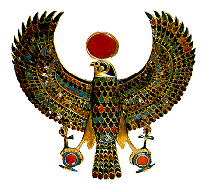
|
Greek philosophy is somewhat of a drama,
whose chief actors were Alexander the Great, Aristotole and his
successors in the peripatetic school, and the Emperor Justinian.
Alexander invaded Egypt and captured the Royal Library at Alexandria and
plundered it. Aristotle made a library at Alexandria and plundered
books, while his school occupied the building and used it as a research
centre. Finally, Justinian, the Roman Emperor, abolished the Temples and
schools of philosophy, i.e., another name for the Egyptian Mysteries,
which the Greeks claimed as their product, and on account of which, they
have been falsely praised and honored for centuries by the world, as its
greatest philosophers and thinkers. This contribution to civilization
was really and truly made by the Egyptians and the African continent,
but not by the Greeks and the European continent.
George G.M. James, Black Historian
|
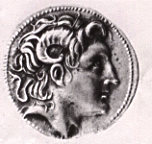
|
This excerpt was taken from the late George GM James' now
historic work "Stolen Legacy," a recommended reading tool of the
National office of Alpha Phi Alpha Fraternity, Inc. In it James proposed
that the origins of Greek philosophy lay within Egyptian theology, what
the Greeks called the Mysteries. His objectives, as he clearly stated,
were as follows: 1.) To prove that Greek philosophy was a misnomer; 2.)
To demonstrate the African origin of the Mysteries Schools; and 3.) To
create a social reformation through the new philosophy of African
redemption. The far reaching implications of Professor James' brilliant
work is staggering. For if the origins of Greek/Classical/Hellenic
thought originated in Egypt then the foundation of Western Civilization
(from Greece to Rome to Europe to America) lays in Africa. Further still
do the implications go when one journeys to the heart of Africa to find
the origins of Egyptian civilization. Pictured above is the Greek
conqueror Alexander the Great. A student of the famed Aristotle, he
invaded Egypt and plundered her libraries. So impressed was the young
Alexander with Egypt that he renounced his own father and claimed
descent from the African Egyptian god, Amen. In this coin he goes as far
as to wear the ram horns, symbolic of Amen.
|
|
Key to this discussion of Africa and Greece are the
so-called Mysteries. The Mysteries as they were called, were
secret religious societies which permeated much of the ancient world.
The Mysteries taught that the greatest good was in the salvation of the
soul. This was done by learning and understanding divine knowledge which
the Mysteries focused upon heavily. When one speaks of the Mysteries it
is usually of the Greek and Near Eastern Mysteries such as the Orphic or
Mithraic traditions. But for the purpose of this discussion, it is best
to focus upon that part of Africa which probably held the oldest
Mysteries. It is from this part of Africa that the very African idea of
divine knowledge and secret society may have spread to such areas as
Greece and the Near East. This region is the Nilotic region, home to the
most ancient societies on Earth: Nubia and Egypt.
|
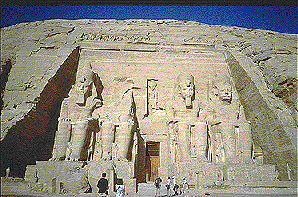
|
The Egyptian Mysteries ,as they were called, were the
repository of ancient African knowledge. Egypt was founded upon these
mysteries and dedicated immense temples to its deities whom the
mysteries were all integrally connected to. One need only to look to
entire cities dedicated to the Egyptian Architect of the Universe, Ptah.
Or to figures such as the Great Imhotep who would be remembered for
millennium as the great architect in his own right. Or perhaps to the
great temples dedicated to gods such as Amen or the great scribe who
held the secret words, Tehuti. But probably the most well known of the
mysteries which would permeate the world was that of the deities Ausar
(Osiris), Auset (Isis) and Horus (Heru). Pictured above is the Temple of
Abu Simbel, an Egyptian temple in Nubia. Many temples in ancient Egypt
were built to recall divine occurrences such as the Creation. Only the
duly initiated could enter into its sacred halls into the Holiest of
Holies. |

|
Ausar, commonly known by his Greek name Osiris, was one of
the most famous neteru (manifestation of God) in Egypt. Heralded as the
first king of Egypt it is believed Ausar is a composite of long dead
kings who lived in ancient times. He is credited with bringing
"civilization" to his people and establishing a code of spiritual laws
and moral standards. The story of Ausar is a long and complex one. It is
said that he ruled Egypt with his wife Auset, who is better known by her
Greek name Isis. According to legend, Ausar was slain by his jealous
half-brother Set, who cut his body into fourteen pieces. He was
eventually resurrected and ruled in the underworld. This documents the
oldest belief of resurrection and immortality in human history. More
importantly however it demonstrates the Egyptian belief in the
immortality of the soul. So it is no surprise that the greatest level of
spirituality one could achieve was to become, though divine knowledge
and understanding, the god Ausar upon transition to the next level of
life (death). The idea of the Mysteries of rebirth after death may be
derived from Ausar. Thus initiates in secret societies are said to die
(mentally) and be born again. Pictured here is the god Ausar.
|
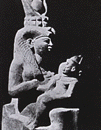
|
Typical of African deities, Ausar had a known consort,
Auset. Auset (Isis) was the wife and sister of Ausar. Like her husband,
she was thought to be an ancestral spirit. Heralded as the Queen of
Egypt, Auset was said to be responsible for bringing writing and
agriculture to the people. She also symbolized the fertility of the
land. One of the original 9 neteru of Creation, it is said that she
gained her power by learning the secret name of her father Ra. Following
her husband's death, Auset searched the land for him. She found his body
only to have Set dismember it into fourteen pieces. Once more she
searched for her husband and located all of the pieces of his body save
his phallus. Auset created the tekhen (obelisk) to symbolize her
husband's missing member. With the help of the neteru Tehuti and Anpu,
Ausar was resurrected. Legend further goes to say that while her husband
was dead, his spirit entered and impregnated her. Shortly thereafter she
conceived a child who would be named Heru. This act represents the first
immaculate concepetion known to mankind. Auset's worship would remain
for several thousand years up to Rome where her temples became numerous.
In fact the Mysteries known as the "Temples of Isis" become the most
famous in the ancient world. Pictured here is Auset with her son Heru.
|
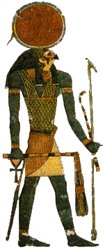
|
Heru is the immaculately conceived son of Auset and Ausar.
At his birth it is said three wise kings or Magi came to honor him while
he was adored by all manner of neteru and men. As an adult, Heru avenged
his father by triumphing over his wicked uncle Set. Heru then journeyed
to the underworld where he sits with his father in judgement of the
dead. Heru's triumph over Set is the orgin of the word "hero" and his
association with the zodiac makes him the source of the word "hour."
Thus the minor deities of the zodiac are the "Watchers of the Hours
(Horus)" or horoscope. He is depicted as a falcon or a man with a falcon
head. Heru became known also as the "child of the light" representing
the sun (knowledge) driving away darkness (Set; the setting sun;
ignorance). From the earliest times in Egypt he came to represent the
living king or divine kingship. This idea of the king as nearly a living
god typifies African ideology and is thought to have come up the Nile
from the south to Egypt. In fact it is said in Egyptian texts that Heru
invaded Egypt from the south (Nubia). The ideas of the Mysteries of
light banishing darkness or knowledge dispelling ignorance is derived
from Heru. It is not surprising that many secret societies speak of
receiving or searching for light (Heru). Some even call themselves
"Children of Light" (Heru). Pictured here is the falcon headed Heru.
|
|
These Mysteries would make their way out of Africa by
way of Egypt, and become an important facet of the Greco-Roman and Near
Eastern worlds. The many Mysteries that existed are too many to recount,
but all trace their way back to Egypt and thus Africa. But the Mysteries
eventually fell out of favor. Supplanted by other religious
philosophies, they disappeared from the ancient world. Or at least, so
it would seem. The importance of the great Mysteries would not be
brought to world recognition again for several centuries. And it would
occur in the most unlikely of places.
|
Written by Bro. Dexter Gabriel. Copyright Mu Nu
Chapter 2000. All rights reserved. Except as provided under U.S. copyright
law, all written information may not be reproduced, resold, distributed or
modified without the express permission the Mu Nu Chapter.
Pictures & Information Courtesy of
Stolen
Legacy by George GM James
Nile Valley Contributions to
Civilization by Anthony T. Browder
Civilization or Barbarism by
Cheikh Anta Diop
Man, God and Civilization by John G. Jackson and
the
Africana Studies
Research Page
|
|
|
|
| |
Online
Poll
|
|
Online
Poll
Quote of the Week
Quiz Question
|
| Advertisements
|
|
|
|
|
|
|